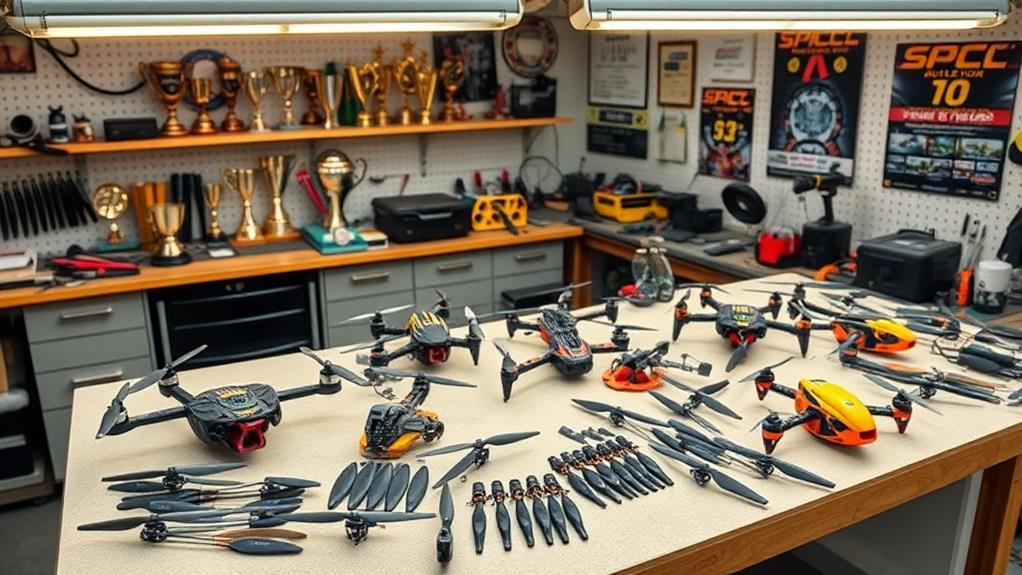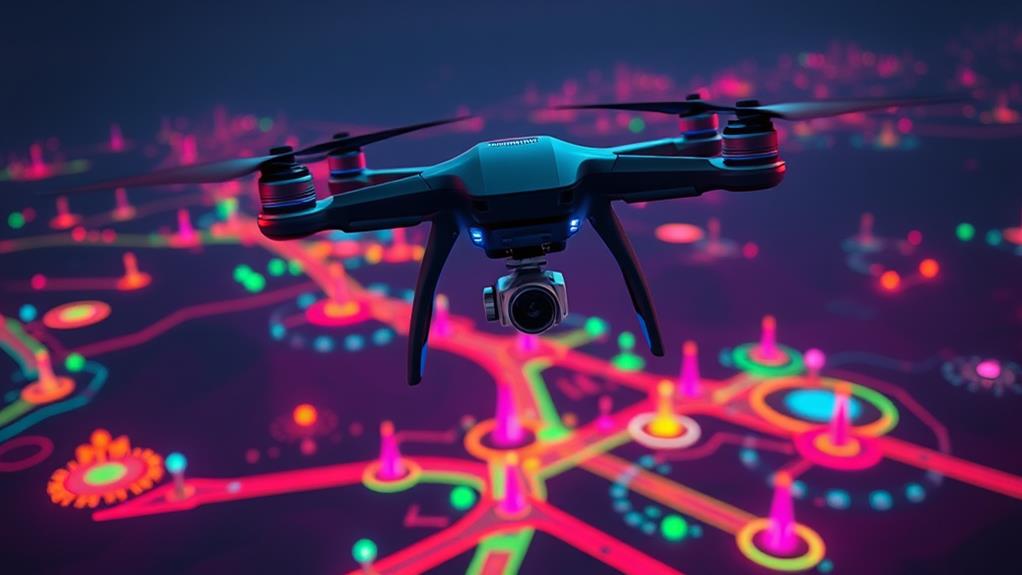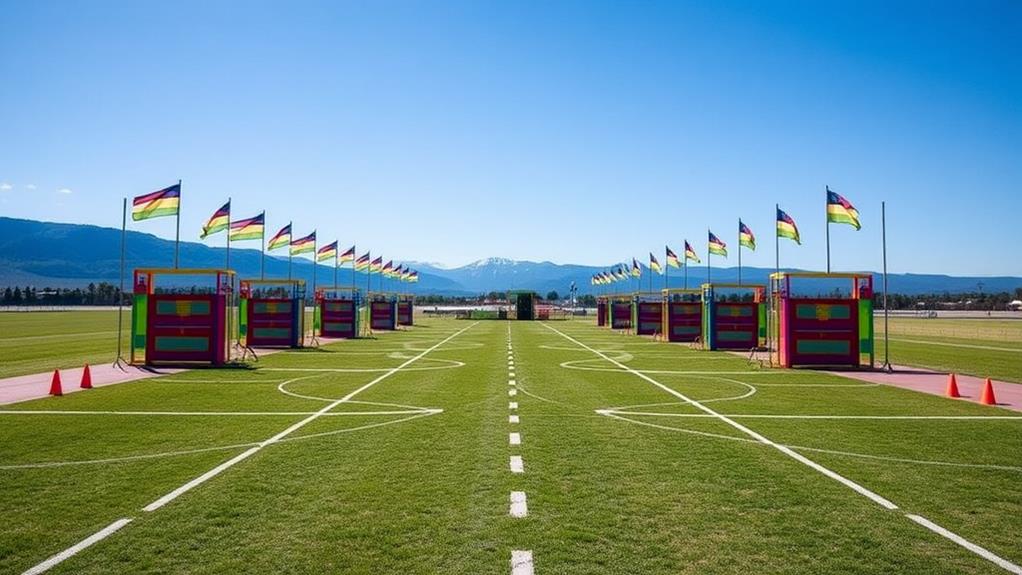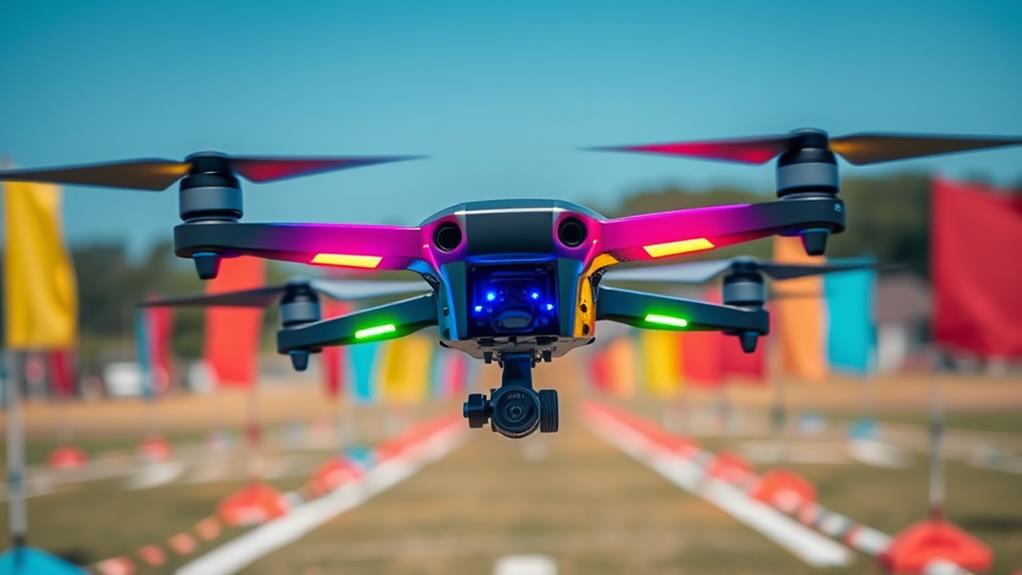To excel in drone racing competitions, you need to prioritize consistent training, which builds muscle memory and sharpens your skills. Analyze your performance by reviewing recorded footage to pinpoint areas needing improvement. Regularly check your equipment to guarantee everything functions well, and consider engaging with the drone community for motivation and tips. Utilize flight simulators for realistic practice and to experiment with strategies. Focus on essential skills like tight turns and slaloms, and incorporate hand strength exercises for better control. Engaging with experienced pilots can further enhance your understanding of advanced techniques, setting you up for success in competitions.
Importance of Consistent Training

Consistent training is the cornerstone of success in drone racing. As a pilot, you need to commit to regular practice to enhance your skills and develop muscle memory. The more time you spend flying your drone, the more familiar you'll become with your equipment and the intricacies of race courses.
Mastering flight basics will also contribute to your overall performance. Treating your practice sessions like real competitions will help build good habits and prepare you for the mental and physical challenges that racing entails.
Engaging in warm-up routines before flying is essential. These routines enhance muscle memory and greatly reduce the likelihood of crashes during races, which contributes to more consistent performance.
Focusing on flying with precision rather than just speed during practice sessions can lead to better results in competitive environments.
Analyzing Performance and Techniques
To truly excel in drone racing, you need to analyze your performance and refine your techniques after every practice session.
Start with a self-critique; identify your weak spots to target specific areas for improvement in your flying techniques. Reviewing recorded footage is important, as it helps you analyze your race lines and individual maneuvers, highlighting ideal entry and exit speeds. Incorporating advanced techniques like the Power Loop can greatly enhance your performance and showcase your skill.
Focus on specific drills during practice, like tight turns and slaloms, to enhance your piloting skills and boost overall race performance. These targeted exercises build muscle memory and improve your reaction times, making you a more efficient pilot.
Additionally, adaptability is essential; analyze your race lines and adjust strategies based on course conditions. This preparation will help you tackle unexpected challenges on race day.
Finally, cultivating a strong mental game through grounding techniques and stress management is critical. It enables you to maintain focus and confidence during competitions, ensuring that you perform at your best.
Equipment Setup and Maintenance

Proper equipment setup and maintenance are indispensable for success in drone racing. You should conduct regular equipment checks using a detailed checklist. This includes inspecting your drone, batteries, transmitter, goggles, and charger to confirm all components are functional before racing. Familiarizing yourself with your drone's components boosts your reaction times and allows you to make quick adjustments during races.
Additionally, following a routine that includes routine inspections helps identify potential issues early, which is important for maintaining performance and safety. Implement a thorough pre-race inspection routine that involves checking battery voltage and confirming all gear is in working condition.
Maintaining a stock of necessary spare parts, especially consumables like propellers and arms, minimizes downtime and keeps you race-ready. If a component breaks, having replacements on hand can make all the difference.
Regular maintenance on your racing drones is essential for peak performance. Clean your drones and repair any damage to assure reliability throughout the racing season. Remember, the condition of your drone directly impacts your performance, so prioritize these tasks.
Engaging With the Drone Community
Engaging with the drone community is essential for your growth as a pilot.
By building supportive relationships, you can participate in collaborative practice sessions that enhance your skills while fostering camaraderie.
Sharing knowledge and experiences with fellow racers not only accelerates your learning but also creates a rewarding atmosphere for everyone involved.
Building Supportive Relationships
Building connections within the drone racing community is essential for your growth as a pilot. Engaging with fellow pilots fosters a supportive environment that enhances your learning and motivation.
Whether you're a novice or an experienced racer, participating in group practice sessions encourages healthy competition and camaraderie. These sessions create opportunities for knowledge sharing, where you can learn techniques that accelerate your skill development.
Celebrating small victories together within the drone racing community strengthens relationships and cultivates a positive atmosphere important for growth.
Social media platforms like Facebook and Twitter are critical tools for community engagement. They allow you to connect, share experiences, and access resources from more experienced racers that can help you improve your skills.
MultiGP actively promotes community involvement through structured events, making it easier for pilots to find a supportive network. These events range from competitive races to casual gatherings, encouraging everyone to participate and connect.
Collaborative Practice Sessions
Collaborative practice sessions can considerably enhance your drone racing skills while fostering a sense of community among pilots. These sessions create a supportive environment where you can learn from both novice and experienced pilots. When you engage in collaborative sessions, you not only improve your own skills but also contribute to the overall growth of the community.
MultiGP, for instance, organizes events that encourage collective practice. Here, you can race alongside others, which promotes camaraderie and healthy competition. During these practice sessions, you'll have the chance to exchange valuable tips and strategies, accelerating your learning process.
Setting specific challenges, like timed laps or obstacle courses, can be particularly motivating. These challenge settings push each participant, including you, to refine your skills.
Additionally, community support often extends beyond just flying. Group discussions and feedback sessions allow you to analyze your performances and pinpoint areas for growth.
In essence, engaging in collaborative practice sessions not only enhances your skill development but also strengthens your connections within the drone racing community. Embrace these opportunities to learn and share—your racing experience will certainly improve!
Knowledge Sharing Opportunities
Knowledge sharing within the drone racing community can greatly elevate your skills and understanding of the sport. Engaging with fellow pilots offers numerous opportunities to enhance your training routine and competitive edge.
Here are four key ways to maximize knowledge sharing:
- Join Local MultiGP Chapters: These groups foster community support, allowing racers to share experiences, tips, and techniques in a structured environment.
- Participate in Group Practice Sessions: These sessions not only provide motivation but also foster healthy competition, enabling you to receive valuable feedback that can sharpen your skills.
- Attend Competitive Gatherings: These events create a platform where you can learn from experienced pilots, observe different racing styles, and adapt strategies to improve your performance.
- Utilize Social Media: Platforms like Facebook and Twitter connect you with the broader drone racing community. Here, you can share techniques, ask questions, and stay updated on events that can enhance your knowledge.
Utilizing Flight Simulators

Using flight simulators like DRL SIM and Liftoff can greatly enhance your drone racing skills by offering a realistic environment that mimics real-world physics.
These platforms allow you to practice essential maneuvers and refine your techniques through structured drills, ensuring you build muscle memory without risking damage to your actual drone.
Plus, engaging with competitive scenarios in the simulator not only tracks your progress but also prepares you for the challenges you'll face in real races.
Realistic Flight Physics
When you're diving into drone racing, realistic flight physics is essential, and flight simulators like DRL SIM and Liftoff are your best friends.
These simulators replicate real-world physics, allowing you to practice flight maneuvers without the risk of damaging your equipment.
Here are four reasons why you should incorporate them into your training:
- Realistic Physics: They mimic actual drone behavior, making your practice sessions relevant and effective.
- Varied Racing Environments: You can experience different MultiGP courses, helping you adapt to diverse racing conditions.
- Muscle Memory: Repeated drills enhance your reflexes and control, vital for competitive success.
- Competitive Aspect: Many simulators feature leaderboards, motivating you to track your progress and improve your skills.
Utilizing flight simulators also allows you to experiment with different drone setups and flight strategies, deepening your understanding of how equipment affects performance.
Skill Refinement Drills
To elevate your drone racing skills, incorporating targeted skill refinement drills in flight simulators is essential. Flight simulators like DRL SIM and Liftoff replicate real-world physics, allowing you to practice and refine your racing techniques in a risk-free environment. Engaging in specific training missions helps you develop foundational skills, while also offering advanced challenges as you progress.
By regularly practicing on simulator tracks that mimic MultiGP course challenges, you gain valuable experience in line negotiation and obstacle avoidance. These drills enhance your adaptability, making you more comfortable during actual race conditions.
Additionally, utilizing public leaderboards fosters a competitive spirit, enabling you to track your improvement against peers.
Experimenting with different camera angles and settings in simulators also contributes to your overall skill refinement, as it allows you to discover what works best for you. The ability to practice consistently in a controlled setting is key to honing your skills and gaining confidence.
Competitive Scenario Practice
Competitive scenario practice in flight simulators is essential for any aspiring drone racer. These tools allow you to hone your skills without risking damage to your equipment, making them invaluable for training.
Here are four reasons to incorporate flight simulators into your routine:
- Realistic Physics: Simulators like DRL SIM and Liftoff replicate real-world racing physics, enhancing your understanding of drone dynamics.
- Customizable Settings: Adjust drone specifications and environmental conditions to simulate specific race day challenges, giving you an edge during competitive gatherings.
- Time Trial Modes: Engage in time trial modes to create a competitive atmosphere and benchmark performance against other pilots.
- Muscle Memory Development: Regular use of simulators greatly improves your muscle memory and reflexes, leading to faster reaction times during actual races.
Developing Mental Resilience
Developing mental resilience is essential for any drone racer aiming to excel in high-pressure environments. To cultivate this resilience, consistent practice is key. It not only builds your confidence but also helps reduce anxiety during competitions.
Before flight, engage in grounding techniques to calm your nerves and prepare your mind for peak performance. These techniques can include deep breathing or visualization to center your thoughts.
After your practice sessions, take time for self-critique. Assess your performance, identify weaknesses, and develop strategies to tackle internal doubts in future races.
Visualization techniques are another powerful tool; mentally rehearse successful maneuvers to enhance your focus and performance when it counts.
Additionally, building a supportive network within the racing community is invaluable. Surround yourself with encouraging peers who share experiences and insights. Their support can greatly improve your mental resilience, making challenges feel more manageable.
Practicing Essential Skills and Drills

Building mental resilience sets the stage for honing your piloting abilities through targeted practice.
To excel in drone racing, you need to master essential skills and drills that enhance your control and precision. Here are four key practices you should focus on:
- Tight Turns: Set up gates to practice steering around sharp corners. This will improve your control when racing through tight spaces.
- Slaloms: Create a series of obstacles to maneuver through. Slaloms help develop quick reflexes and enhance your ability to maintain speed while making directional changes.
- Figure 8 Drills: Practice flying in a figure 8 pattern to improve your directional changes. This drill is vital for efficiently steering through complex race courses.
- Review Footage: After each practice session, analyze your flying. Watching your footage can help you identify areas for improvement and learn techniques from top pilots.
Building Hand Strength for Control
Hand strength plays an essential role in drone racing, as it directly impacts your control and precision during flights. For drone pilots, enhancing grip strength is important for reducing fatigue during extended sessions, ultimately boosting your flying performance. One effective exercise involves squeezing a tennis ball; aim for ten repetitions three times a day to build grip strength.
Additionally, practice thumb opposition exercises, where you touch the tip of each finger with your thumb. This helps improve finger dexterity and strength, which are essential for precise maneuvering of your drone. Engaging in finger abduction exercises—spreading your fingers apart against resistance—also enhances hand strength.
Combine this with wrist stretches to improve flexibility, reducing the risk of injury during races. Incorporating these exercises into your training regimen consistently will lead to better control of your drone.
You'll notice smoother and more responsive flying as your hand strength develops. By focusing on these essential exercises, you're setting yourself up for success in drone racing competitions, ensuring that your skills aren't just about technique but also about the strength and control in your hands.
Learning From Experienced Pilots

Learning from experienced pilots can drastically boost your skills in drone racing.
By observing their techniques and asking for advice, you'll uncover valuable strategies that can enhance your flying performance.
Embracing competition with these seasoned racers not only challenges you but also accelerates your growth as a pilot.
Techniques From Pros
Watching experienced pilots in action offers invaluable insights into the world of drone racing. By observing their techniques, you can adopt strategies that greatly enhance your performance.
Here are four key takeaways to improve your racing skills:
- Analyze Race Footage: Review videos of pros to identify effective racing lines and maneuvers. This practice helps you adapt techniques that suit your style.
- Engage in Discussions: Talk to seasoned racers about their strategies for maneuvering complex courses. Their insights can reveal best approaches you mightn't have considered.
- Practice Specific Techniques: Focus on practicing tight turns and slalom navigation, as these are critical skills for reducing lap times and increasing efficiency.
- Mental Preparation: Learn how top pilots manage race-day nerves. Incorporating their mental techniques can enhance your focus and performance under pressure.
Embracing Competitive Challenges
Facing off against seasoned pilots in drone racing is an exhilarating experience that can greatly boost your skills. Competing in these competitive gatherings provides a unique opportunity to learn from top pilots. Their experience can offer you valuable insights into efficient racing strategies that can enhance your flying speed and techniques.
Participating in group practice sessions with advanced pilots creates a supportive environment where you can challenge yourself, helping accelerate your learning curve.
Don't hesitate to inquire about specific techniques from these experienced racers; they can share proven methods that improve race performance and reduce lap times.
Embracing competitive challenges, like racing against top pilots, allows you to develop resilience and adaptability—essential traits for success in high-pressure situations.
Recognizing that competition is an opportunity for growth encourages a mindset focused on continuous improvement and skill enhancement in drone racing.
Preparing for Race Day Challenges
While the excitement of race day can be overwhelming, arriving early at the venue is key to overcoming potential challenges. This preparation guarantees you're ready to tackle whatever comes your way.
Here are four essential steps to take into account:
- Participate in Pre-Race Briefings: These meetings clarify rules, schedules, and safety protocols, helping you feel informed and confident.
- Conduct Practice Laps: Use this time to familiarize yourself with the course. It allows you to refine your strategies and spot potential obstacles.
- Focus on Team Preparations: Collaborate with your team to establish effective communication. This coordination is essential for maneuvering unexpected challenges during the race.
- Manage Your Mental Focus: Implement stress management techniques to reduce anxiety. Staying calm and focused enhances your reaction times, critical for competitive racing.
Conclusion
In drone racing, consistent practice and skill refinement are your wings to success. By analyzing your performance and engaging with the community, you'll sharpen your techniques and build crucial connections. Utilize flight simulators to hone essential skills, and never underestimate the importance of physical preparation. As race day approaches, remember that preparation is key. Embrace the challenges ahead, and let your passion for flying propel you to new heights in this thrilling sport.

Leave a Reply